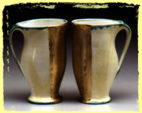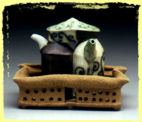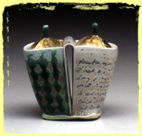



Cream and Sugar Set


Cup Set


Double Spouted Ewer
Forrest Snyder
Julia Galloway spoke with Forrest Snyder from Critical Ceramics late in the summer of 1999 while team-teaching with Alec Karros at the Haystack Mountain School of Crafts. Julia will return to Haystack this fall, 2000, to teach a four day workshop.
Critical Ceramics: What’s your background?
Julia Galloway: I was an undergraduate at Alfred from 1984 to 1988. Then I took two years off, during which I went to Japan for a summer. When I returned, I had a bit of a crisis. I thought, “all the good pots have been made. Who was I [to improve this body of work]?”
CC: That feeling hit you right away?
JG: Yes. It was so obvious. I had taken two years off and done large installations and performance art in Boston. I worked mostly with wine, manure, and hay in a big industrial space. After those two years, I realized that all those installations were very much about the same things that pots are about.
CC: Which is?
JG: Well, they’re about making spaces to sit and talk. Making small, intimate spaces out of huge spaces. I’m trying to personalize this urban/industrial world. You know, when you’re in the city and you smell hay, it’s kind of profound.
CC: At least a wake up call.
JG: Exactly. Then I realized that you couldn’t take it with you. At the end of each installation was this odd, uncomfortable time. I decided that pots were a better way to address my concerns. Plus, I grew up enough [during those two years] and realized that I could make pots that weren’t Japanese!
CC: What happened next?
JG: I went to Mass College of Art for a year as a special student. I was there with some great students. In 1992, I went to the University of Colorado - Boulder for graduate school. I went there to study with Betty [Woodman]. With Betty, I wanted to study with a woman from an era. The Voulkos, Soldner, era.
CC: The first generation of modern ceramics.
JG: Right. I felt that it was very important to study with someone of that era.
CC: Next, came...?
JG: My second to last semester at Boulder, I went to the Nova Scotia College of Art and Design [NASCAD]. I needed to work with more potters. There were no potters at Boulder!
CC: Why NASCAD?
JG: Its ceramic history and to work with Walter [Ostrom]. I felt at Boulder that I was defending pots all the time. I wanted to go to a school where [pottery] was taken for granted.
CC: Defending pottery?
JG: Yeah. I feel that if there’s not a preexisting history or structure [in the institution] then you end up defending pottery because it is a craft. Boulder is really a studio arts school. Don’t get me wrong, I don’t regret going there for a minute. I just needed to be somewhere to give me a little bit more backup. I needed some basic, historical, pottery knowledge. In graduate school, I learned all about installation, photography, video... that was really great, but I had to learn about Mesopotamia, Italy, and the Chinese. I just didn’t have any of that background.
We had this teacher, Marie Elwood, a curator, who basically took us over the Silk Road. She taught the ceramic history all through commodity and trade. There was no question. That history wasn’t about art and pots at all. She’d talk about those pots trading back and forth and then she’d open up her suitcase and pull one out! She had access to all these pots in the museums. It was outrageous!
CC: After graduate school, how or why did you make the transition into teaching?
JG: I did a sabbatical replacement at William and Mary College. It was great because they just let me flail wildly. I mean, in your first year of teaching, what are you going to get made? A couple of cups would be good! Anyway, up until then, I had my doubts about teaching. What I found was that I learn so much when I teach. Being in an academic environment keeps my brain going.
Before William and Mary, I went to the Archie Bray Foundation. I was there for almost two years. A really good thing about being at the Bray was I decided that I had to figure out if pottery was going to be a career. The big “C” word. Becoming a professional is a big step.
CC: The Bray gave you time and space to refine?
JG: Yes. I think you figure out what you want to do and how you want to present yourself in a way that feels true. What’s so nice about the Bray, too, is that when you walk through the grounds, there’s work from everyone that you’ve ever heard of or studied. There’s a dusty old Peter Voulkos platter hanging on the bathroom wall. I got the sense of being part of a larger community. With that realization came a sense of responsibility. I thought, “oh, I’m part of this. Oh, I’m REALLY part of this. Where are we going from here?” I do feel very much part of the next generation. I understand the [recent] history, but that’s not my generation.
CC: What is your responsibility, then?
JG: Scott Chamberlin would always ask, “so, how are you adding to the larger body of knowledge?” I believe that one must put the best of what one can back into the field so that it can grow and become richer.
CC: How do you reconcile that idea with the idea that you had when you returned from Japan? The idea that you could never make a pot that hadn’t been made before?
JG: Interesting. I’ve never put those two [ideas] together before. Basically, I think that I’ve grown up. I have a better understanding of the ceramic world. It’s bigger than shino or temmoku.
CC: Can you define what you want to put back into the field?
JG: I don’t know how to answer that future question directly, but I can tell you some things I’m interested in. I’m thrilled by the quality of utilitarian pottery being made in America, today. I want to help that to continue to grow stronger. Technically and formally, we’re so much better than ten years ago. Potters today seem smarter, clearer, more articulate. I want that momentum to continue. You know, when I was at Alfred, I never heard the word ‘craftsman’ used outloud until 1988.
CC: Are there trends or qualities that you don’t like?
JG: I’m really, really, really tired of black lines on orange flashing. Across the board. Woodfire, that stripe/flash is kind of the raku of the late 1990’s. The Ruggles and Rankin style has consumed our field! Don’t get me wrong, they make some lovely pots; the problem is, now lots of other people make lovely Ruggles and Rankin pots, too. But this phenomena isn’t unique to pottery. Look at how many people are Martin Puryer once removed!
CC: Hasn’t the quality of all the arts risen in the last ten years?
JG: Yes, although more has been lost, too. Because there’s less of something to bounce off of. The sculpture world, overall, is under tremendous stress. Anything goes in such a way that it’s unclear what even goes. This may be a product of more and better.
CC: Has the marketplace influenced the crafts world? The academic world?
JG: That’s funny. In one way, I feel like grad students are always on the cutting edge [of contemporary art]. On the other hand, I think that it takes forever for the [academic] institutions to catch up. How do these two go together? There’s truth in both.
The public is willing to pay more for pots today. People are more interested in the handmade looking objects. Walk into Pier 1 Imports and have a look. There is a smaller, more sophisticated, audience that is willing to pay a premium for the handmade decorative object. These people are my target audience. I’m not competing with mass retail or industry - I can’t - but I sell out [my shows].
CC: What are you trying to achieve with that pitcher or this mug?
JG: Two things. First, the making process is the most exciting thing to me. However, I wouldn’t do it and have nothing to show for the effort. I’m not a performance artist. Second, by show a relationship between two objects - creamer and sugar bowl, for example - I hope to get the user thinking about their own relationships; on some level they have a relationship with my object and, through that, a relation to me, the maker.
CC: Is the challenge to make this purpose as clear as possible or as obscure as possible?
JG: Hopefully, you do both! In the most clear part, I want users to know that the piece is part of a pair or group. Salt and Pepper. Oil and Vinegar. Cream and Sugar. Then, as the piece gets used, becomes known, I hope there’s a deeper, more obscured, non-verbal understanding.
CC: How do you approach making a body of work?
JG: The biggest changes to the work happen when I have to move. When I move, the work changes. I worry about changing [either too much or not enough], but I shouldn’t really. Daily, I always have a plan. Today, I’m working on teapots and cream and sugar sets.
CC: Finishing up, is there anything else you’d like to touch on?
JG: I’d like to say one thing that’s been on my mind. Since, I’ll be teaching at the Rochester Institute of Technology, School for American Crafts, I’ve become a bit perplexed as to how modern technology and pottery meet. Then Linda Sikora put a new light on the two. She pointed out that practitioners in both fields are absolutely obsessed with process.

Salt and Pepper Set


Teapot on Trivit


Pitcher/Vase Set